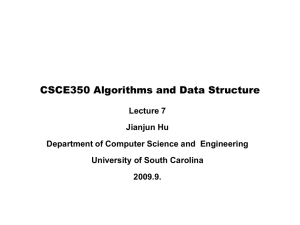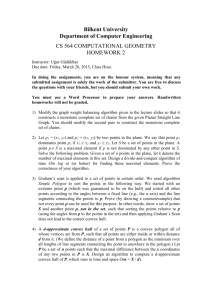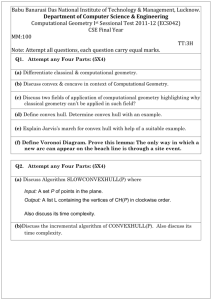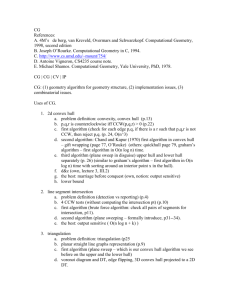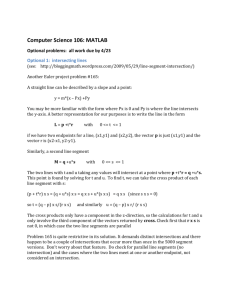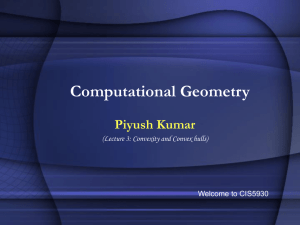Lecture27MRM
advertisement
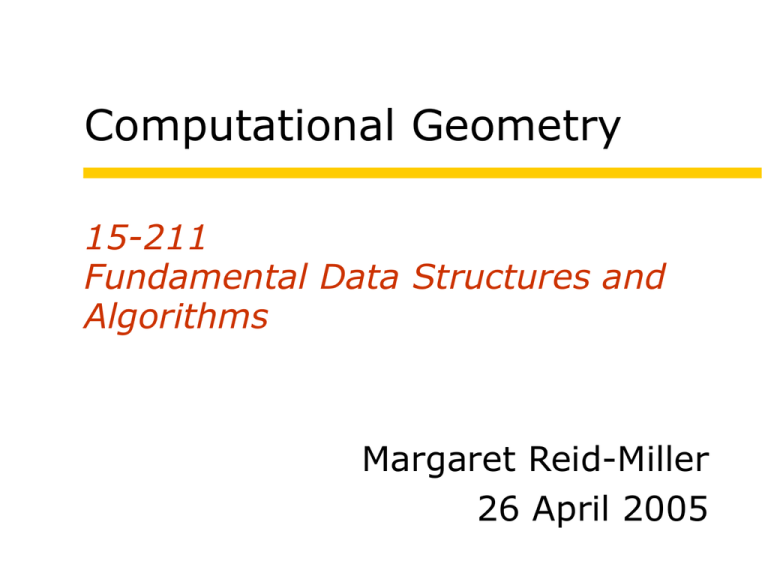
Computational Geometry 15-211 Fundamental Data Structures and Algorithms Margaret Reid-Miller 26 April 2005 Announcements HW6 the clock is ticking ... FCEs Final Exam on Thursday May 5, 8:30am-11:30am review session April 28 The Basics Computational Geometry Lots of applications: computer graphics CAD/CAM motion planning maps simulation Could be done in dimension D, but we will stick to D=2. D=3 is already much harder. Airplane wing triangulation Moving Mesh QuickTime™ and a YUV420 codec decompressor are needed to see this picture. The Basics What are the basic objects in plane geometry, how do we represent them as data structures? - point two floats - line two points - ray two points, constraints - line segment two points, constraints and triangles, rectangles, polygons, ... Never mind curves such as circles and ellipses. Disclaimer There are two annoying issues one has to confront in Computational Geometry algorithms. - Degenerate Cases Points are collinear, lines parallel, … Dealing with degeneracy is a huge pain, not to mention boring. - Floating point numbers are not reals. Floating point arithmetic introduces errors and hence leads to accuracy problems. High Precision Arithmetic If 32 or 64 bits are not enough, use 128, or 512, or 1024, or … Problems: We have to be able to analyze how many bits are required. Slows down computation significantly. See GNU gmp. Interval Arithmetic Replace “real number” x by an interval xL x xU Problems: Arithmetic becomes quite a bit more complicated. Slows down computation significantly. Symbolic Computation Use (arbitrary precision) rationals and whatever algebraic operations that are necessary symbolically: compute with the formal expressions, not their numerical values. Sqrt[2] Problems: Manipulating these expressions is complicated. Slows down computation significantly. Warm-Up Let's figure out how to check if a point P lies on a line L. P = (p1,p2) L = (A,B) two-points representation Need P P = A + l (B - A) B where l is a real parameter. A P Linear Equations The vector equation P = A + l (B – A) = (1- l) A + l B is just short-hand for two linear equations: p1 = a1 + l (b1 – a1) p2 = a2 + l (b2 – a2) Will have a common solution if P lies on L. Subroutines Solving systems of equations such as p1 = a1 + l (b1 – a1) p2 = a2 + l (b2 – a2) is best left to specialized software: send all linear equation subproblems to an equation solver - that will presumably handle all the tricky cases properly and will produce reasonable accuracy. Rays and Line Segments What if L =[A,B) is the ray from A through B? No problem. Now we need B P = A + l (B - A) where l is a non-negative real. A Likewise, if L = [A,B] is the line segment from A to B we need B 0 l 1. A Both l and (1 – l) must be non-negative. Intersections How do we check if two lines intersect? A + l (B - A) = C + k (D – C) Two linear equations, two unknowns l , k. Add constraints for intersection of rays, line segments. B C A D General Placement Here is a slightly harder problem: Which side of L is the point P on? P P left on B P A right Left/Right Turns March from A to B, then perform a left/right turn. left on B right A Calculus: Cross Product The cross product of two (3-D) vectors is another vector perpendicular to the given ones Z=XY Length and direction of Z express the signed area of the parallelogram spanned by the vectors. antisymmetric: XY=-YX Calculus: determinants In 2-D the analog to the cross product of vectors X=(x1, x2) and Y=(y1, y2), is the determinant | x1 x2 | = x1 y2 – x2 y1 | y1 y2 | which is the (signed) area of the parallelogram spanned by X and Y. (y1,y2) (x1,x2) Determinants and left/right turns Let P=(p1,p2), A=(a1,a2), B=(b1, b2) If the area of the parallelogram spanned by B-A and P-A is 0: then P is on the line (A, B) >0: then P is to the left of (A, B) <0: then P is to the right of (A,B) where the area is the determinant P = (p1,p2) |b1-a1, b2-a2| D = |p1-a1, p2-a2| B = (b1,b2) A = (a1,a2) Determinants Alternatively one can compute the determinant of the matrix a1 a2 1 b1 b2 1 p1 p2 1 This may be a better solution since presumably the determinant subroutine deals better with numerical problems. Some Applications Membership How do we check if a point X belongs to some region R in the plane (triangle, rectangle, polygon, ... ). X R R X X X Membership Clearly the difficulty of a membership query depends a lot on the complexity of the region. For some regions it is not even clear that there is an inside and an outside. Simple Polgyons A polygon is simple if its lines do not intersect except at the vertices of the polygon (and then only two). By the Jordan Curve Theorem any simple polygon partitions the plane into inside and outside. Point Membership The proof of the JCT provides a membership test. Let P be a simple polygon and X a point. Draw a line through X and count the intersections of that line with the edges of P. Odd One can show that X lies inside of P iff the number of intersections (on either side) is odd. Note that there are bothersome degenerate cases: X lies on an edge, an edge lies on the line through X. Maybe wiggle the line a little. Algorithm Theorem: One can test in linear time whether a point lies inside a simple polygon. Linear here refers to the number of edges of the polygon. And, of course, we assume that these edges are given as a list of points, say, in counterclockwise order. Convexity Here is one type of simple region. A region R in the plane is convex if for all A, B in R: the line segment [A,B] is a subset of R. In particular convex polygons: boundary straight line segments. Membership in Convex Polygon Traverse the boundary of the convex polygon in counterclockwise order, check that the point in question is always to the left of the corresponding line. This is clearly linear in the number of boundary points. Intersections of LSs Suppose we are given a collection of LSs and want to compute all the intersections between them. Note that the number of intersections may be quadratic in the number n of LSs. The brute force algorithms is (n2): consider all pairs of LSs and check each pair for intersection. Bad if there are only a few intersections. Use of the Geometry Suppose there are s intersections. We would like a faster algorithm with running time O( (n+s) ??? ) where ??? is small. Such an algorithm is called an output-sensitive algorithm. How do we avoid testing all pairs of segments for intersections? Use the geometry: segments close together are candidates for intersections while segments far apart are not. x Sweep Line The key idea is to use a sweep line: Moves from left to right. Maintain the set of line segments that intersect with the sweep line. When does the set change? These points are called event points. Sweep Line When the sweep line reaches the left endpoint of a segment, the segment must be added to the set and tested for intersection with other segments in the set. When the sweep line reaches the right endpoint the segment can be deleted from the set. Still quadratic, even if s is small, though. Can you think of an example? Neighbors Notice how a segment needs to consider only its immediate neighbors wrt to the sweep line. Sort the segments from bottom to top as they intersect the sweep line. q<r<s<t t s r q SL Operations The SL has to keep track of all the LSs that currently intersect it. So we need operations insert(s) delete(s) where s is a given LS. The “time” when the segments are inserted/deleted are given by the end points of the input LSs. (Static events, preprocess by sorting.) Detecting Intersections When a new LS is entered, we have to check if it interacts with any of the neighboring LSs. So we need additional operations above(s) below(s) which return the immediate neighbors above/below on the SL. Sweep line operations What is an appropriate data structure for these operations? insert(s) delete(s) above(s) below(s) Sweep line operations What is an appropriate data structure for these operations? insert(s) delete(s) above(s) below(s) Answer: a dictionary, like balanced binary trees. Then each operation can be done in O(log n) time. May want a threaded tree to get O(1) above/below operations. Detecting Intersections Notice that the segment ordering changes at intersection points. These intersections are dynamic events points, not known ahead of time. When two segments change their order, each may get one new neighbor against which it needs to test for an intersection. Each new intersection becomes a new event point, assuming it was not detected earlier, which can occur if the segment pair were adjacent before. Events Only consider possible lines at: segment endpoints - known initially intersections - insert dynamically Need to be able to remove next event. Events • What is an appropriate data structure to keep the positions of the sweep line? Answer: priority queue! Sweep algorithm Insert all segment endpoints into the queue Q While Q not empty, extract next event E If E = segment left point, insert segment into SL dictionary based on its y-coordinate. Test for intersection with segment immediately above and below. If E = segment right point, delete from SL dictionary. Test for intersection the segments immediately preceding and succeeding this one. If E = intersection, swap the intersecting segments in the SL dictionary. Test the new upper segment for intersection with predecessor. Test the new lower segment for intersection with successor. Theorem: Can compute all s intersections of n line segments in O((n+s) log n) time steps. Testing Simplicity How do we check if a polygon is simple? Use the line segment intersection algorithm on the edges. Polgyon Intersection How do we check if two simple polygon intersect? Note: two cases! Polgyon Intersection The first case can be handled with LS intersection testing. For the second, pick any vertex in P and check wether it lies in (the interior of) Q. Total running time: O(n log n). Convex Hulls A Hull Operation Suppose P is a set of points in the plane. The convex hull of P is the least set of points Q such that: - P is a subset of Q, - Q is convex. Written CH(P). This pattern should look very familiar by now (reachability in graphs, equivalence relations, ...) Convex Combinations Abstractly it is easy to describe CH(P): is the set of all points X= li P i where 0 li and li = 1. X is a convex combination of the Pi . So the convex combinations of A and B are the line segment [A,B]. And the convex combinations of three points (in general position) form a triangle. And so on. So? Geometrically this is nice, but computationally this characterization of the convex hull is not too useful. We want an algorithm that takes as input a simple polygon P and returns as output the simple polygon CH(P). CH(P) P Extremal Points Point X in region R is extremal iff X is not a convex combination of other points in R. For a polygon, the extremal points make up the CH. CH Algorithms Let us assume that the input is given as a set (list) P of n points p1 ,p2, ...,pn in the plane. Example, 1.223, 8.344, -21.222, 21.832, 14.435, 29.439, 29.982, -6.872, 2.322 21.232 38.233 12.780 31.023 29.532 2.879 35.671 We need to compute the extremal points and ouput them in some natural order (say, traversing the boundary of the hull counterclockwise, starting at the south-east corner). However, the input may not be ordered in any particular way. An Observation So let's deal with a set of points P rather than regions. Lemma: Point X in P is not extremal iff X lies in the interior of a triangle spanned by three other points in P. An Algorithm Hence we can find the convex hull of a simple polygon: for all n points we eliminate non-extremal points by trying all possible triangles using the membership test for convex polygons. In the end we sort the remaining extremal points in counterclockwise order. Unfortunately, this is O(n4). Could it be faster? When do we get n4? Computation and Physics Note that there is a simple analogue algorithm to solve the convex hull problem: use a board, nails and a rubber band. Is linear (analog) time. Extremal Points It is easy to find a few points guaranteed to be on the convex hull. p0 Quick Hull Idea Find two points p and q such that [p,q] is a chord in the convex hull of P. Split the points into “above” and “below” the baseline [p,q]. Upper Half Find the point r furthest from the baseline. all points in the triangle (p,q,r). Discard Repeat In the end only the extremal points are left over. Comments The divide step is clearly linear (in the number of points on that side). Combining the solutions is trivial here: we can just join the lists of extremal points. This is very similar to Quicksort. Analysis When does this approach work well? When does it work poorly? What is the running time in general? What is average running time on uniformly random points? Can we force fast behavior? Analysis When does this approach work well? Many points on the interior. When does it work poorly? All points on the hull and imbalanced splits O( n2) What is the running time in general? O( n log n) What is average running time on uniformly random points? O( n ) Can we force fast behavior? Lower Bound for CH O( n log n ) is optimal for convex hull. Show that Sorting can be reduced to Convex Hull. Consider n positive real numbers xi. Define pi = (xi,xi2). Easy to see: are all extremal. Traversing the boundary of CH(P) produces a sorted list. Application: Membership Test The output convention makes algorithmic sense: we can then test in logarithmic time whether a point lies in the convex region. Q Q Membership Test c't Find central point p, then use binary search to identify the sector that Q belongs to: between rays [p,pi) and [p,pi+1). Check if Q lies in the corresponding triangle. Q p Q pi pi+1
